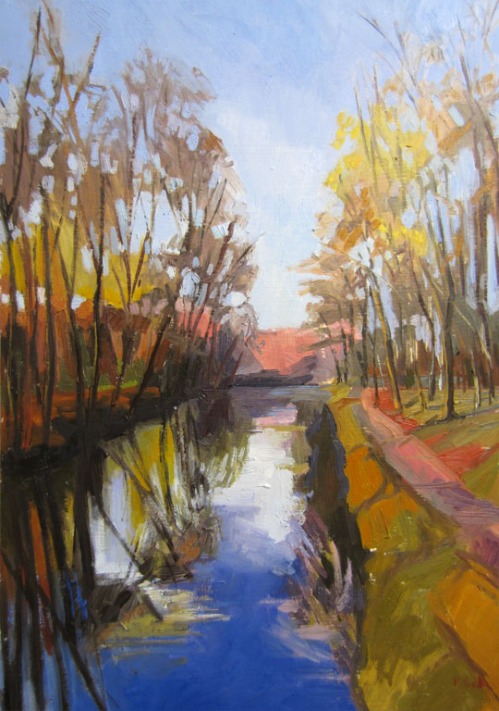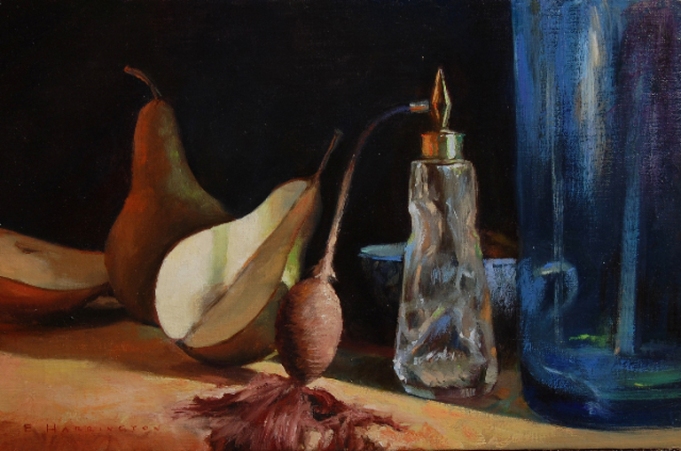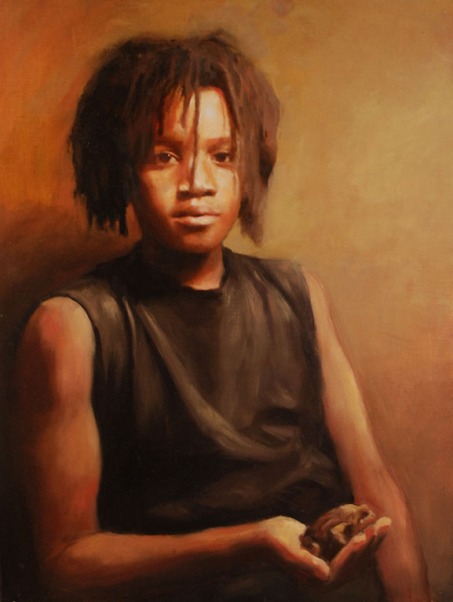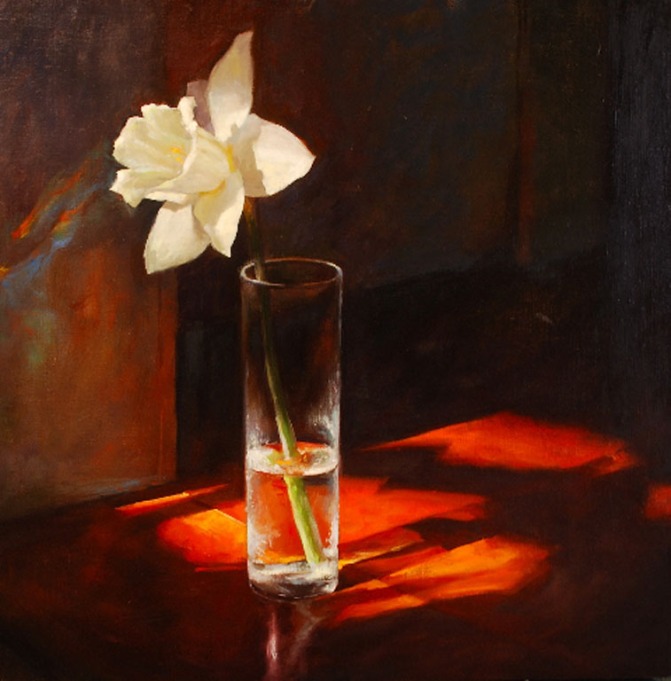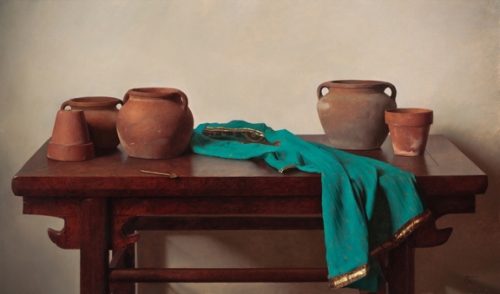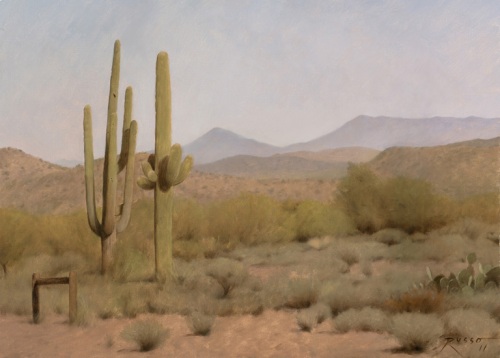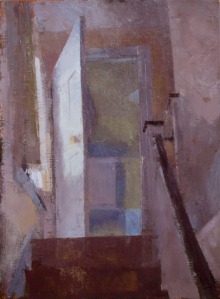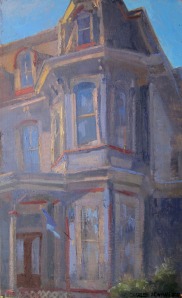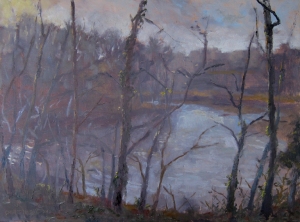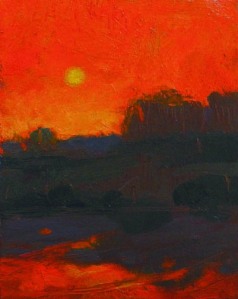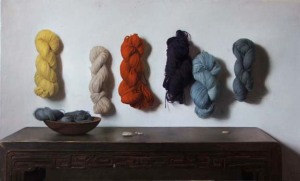Carlo Russo is teaching some workshops. Follow the link for more information
Tag Archives: still life
January Group Show
We are excited to show the work of so many of our wonderful artists this month. The show includes works by Gregory Prestegord, Serge Zhukov, Jesse J. Gardner, Charles Newman and Joshua Koffman. Also new paintings by Claire Haik, Kate Kern Mundie, Neil Berger, and David Bottini.
The show features figurative sculpture by Joshua Koffman. Urban landscapes by Neil Berger, Kate Kern Mundie, Jesse J. Gardner, and Gregory Prestegord. Winter landscape by Serge Zhukov. Still life and landscape paintings by Charles Newman. Rural landscapes by David Bottini and Claire Haik.
Filed under Events
Interview with Kate Kern Mundie

Kate Kern Mundie, City Hall in Fog, 14 x 12 inches, oil on panel
Kate Kern Mundie is exhibiting 30 paintings at F.A.N. Gallery for the month of December. Her work in this exhibition is a mixture of landscape, still life, and interiors.
Q: How would you describe your work? What inspires you to put brush to surface?
A: I paint because I like to lose myself in the experience of painting. There is a rhythm to painting: you examine the subject – landscape, still life, what have you; you mix the colors and brush them onto the surface; you step back and look again; you ask yourself if this is an honest interpretation; and repeat over and over.
Q: What is your first creative memory?
A: When I was four years old, my mother sent me to art classes at the St. Louis Art Museum. I have no memory of the classes except looking at a Picasso painting. I cannot remember what I thought of it at the time, but the painting became seared into my brain. We moved from St. Louis to Boston, so I had not seen that painting for years. I came across the painting in a book many years later when I was in college and was very excited to see it again.

- Image via St. Louis Art Museum: Pablo Picasso, Pitcher and Fruit Bowl, 51 1/4 x 76 3/4 inches, oil on
Q: What was it about that painting that appealed to you? Do you think it has an influence on your work today?
A: I would do “exquisite corpse” drawing with my dad and the line work in the painting looked like the drawings we did. I also really love the leaf shapes. I don’t know if it has any influence today but I wonder if I had not seen the painting and had such a connection to it would I have ended up a painter?
Q: Do you have a creative habit? How do you shape your art making practice to nurture your work?
A: I am trying to make a creative habit. As I get busier with kids, family, and work building in time to make artwork is a challenge. My husband is also an artist so I cannot be selfish and sneak away to the studio all the time. I end up working in bursts; I will paint for a few days and then nothing for a week or more. However, I am trying to be more mindful about scheduling dedicated art-making time.
Q: What do you read, listen to, or look at to recharge you or fuel your work and find inspiration?
A: I read a great deal. I usually have two or three books going at the same time – a mixture of fiction and non-fiction. The best books I have read in 2012 are The Creative Habit by Twyla Tharp and Wittgenstein’s Mistress by David Markson.
While I paint, I like to listen to music – such as Charles Mingus and Joe Strummer, or I listen to the news and interview programs on NPR.
Al Gury taught me the importance of keeping a journal. Journaling helps you learn to write better. Writing about your own work can make narrative themes stand out and can help you to better understand and develop your work. It’s also great when you are applying for a grant and can take great chunks out of your journal and clean up into an application essay.
I look at a lot of art. I really like the work of many of my contemporaries like Alex Kanevsky, Tim McFarlane, Jon Redmond, Stanley Bielen, Katy Schneider, Peri Schwartz, and Jenny Saville. I look to the Ashcan School painters like George Bellows, Edward Hopper, and John Sloan for inspiration.
Q: What do you do for fun when you are not in the studio?
A: I spend time with my family, taking my kids on bike rides. I do yoga to unwind, and have begun to teach it as well. I like to watch movies. When it comes to movies, my tastes are all over the place. I like movies by directors like Hitchcock, Frank Capra, John Woo, Yimou Zhang, Quentin Tarantino, and Guy Ritchie.
F.A.N.’s Newest Painter: Evan Harrington
For June 2012 we welcome a new artist to F.A.N. Gallery. Evan Harrington is a Bucks County native. He received his fine art training at various ateliers here and abroad, and is a graduate of the Pennsylvania Academy of the Fine Arts.
I wanted to find out a bit more about F.A.N.’s newest painter.
What advice has influenced you?
I am particularly interested in the advice given by musicians and athletes. They seem to experience the same situations and hurdles as a working artist, but from a different perspective. Two things stand out in my mind: practice and vision. Every time I pick up a brush or a pencil, I feel it is working towards improving my ease with the mediums. Each drawing and painting I work on, no matter how simple or complex, is working towards improving my hand-eye or hand-mind coordination. “Visual calisthenics” is what one of my friends calls it. Vision is the other major influence on my studio practice. It is important to be relaying some thought or visual idea through each piece of art. Some songwriters circle one theme their entire careers while others change it up with each piece they produce. Either way, vision is the backbone to the art I create.
Who taught you the most about art?
My father taught me how to paint and draw from an early age. My mother was instrumental in getting me to lessons and encouraging me. I had quite a few influential instructors along the way that helped me reach some of my own goals. I have always spent a good deal of time looking through books on various artists, which has expanded my knowledge and perspective of art. Of course, there is a huge component of self-discovery, which is also essential to a healthy growing artist.
Your father is an artist. Do you discuss art or your work with him? How is your work similar or different from his?
My dad, Glenn Harrington, has been working as a professional artist for over 30 years. We discuss art quite frequently. Most of the time, we bounce ideas off of each other.
It is hard for me to keep my work free and spontaneous while creating a large body of work for shows so it really helps that my father is constantly pushing me to branch out and try new ideas.
Many people do see our work as similar and some as entirely separate. I am so familiar with his work and so closely connected to mine, that I have no perspective in being able to see the differences or similarities. I rarely see him paint a still-life, and that is my main subject, so I suppose that is a considerable distinction. I can also sometimes detect our differences in brush work. One thing that I know we both share our interests in the same painters and paintings. Whenever we go to a museum or flip through a catalogue, we frequently agree on our favorite artwork.
When you are in need of inspiration are there particular things you read, listen to, or look at to fuel your work?
Every avenue of my life inspires painting. Seeing new places, meeting up with friends, a wonderful painting, all encourage me to get back to the easel. I thrive off of absorbing beauty and history while in the studio. A lot of times, this comes in the form of books. Sorolla, Degas, Kline, Sargent, Garber, and Velazquez are among my most frequently visited artists. I listen to every type of music available, it helps keep the energy and focus level up. My hobbies, which include tennis and aviation, help bring balance to my life and naturally inspire.
How did you get into aviation?
As a kid, I spent several Saturdays going to the local regional airport to watch planes depart and land with my family. Also, I was fortunate to travel a good deal when I was young, so airports have always been an exciting place for me. A year ago I went up for my first lesson and have loved it ever since. It’s a great way to get out of the studio and gain perspective. It truly feels like another world when you are 5,000 feet above the ground. I have always loved looking at maps, so the visuals of aerial perspectives fascinate me. One flight early on in my training I remember seeing New York City and Philadelphia clearly at the same time, and only 3,000 feet above the earth’s surface. This was an eye opener for me; it was probably a similar feeling for those astronauts who were able to see the earth as round for the first time.
Do you have a pilot’s license?
I do not have my license quite yet. Painting is priority, then flying. My goal is to have it done by the end of summer so I can move onto getting my instrument rating. I have quite a few friends who are pilots, so I fly with them frequently. I am unable to log flight hours with them, but I still gain the experience.
How do you hope your work will grow? Are there any other themes you wish to explore with your work?
I am not sure what direction my work will take this next year. Often I look through my latest body of work, select the pieces that I think are strongest, figure out why they are particularly successful, and then replicate those principles in my next body of work. I have practiced painting everything while I was in school and up to now, so I have prepared myself to be technically ready for whatever lies ahead. My goal is to dig deeper than the surface classifications of subject and theme and perhaps explore things like texture or pattern. The unknown is what keeps the process really exciting.
Filed under Artists
Interview with Carlo Russo
Carlo Russo crafts beautiful paintings reminiscent of 19th century works. His work hints at the influence of orientalism in western art of the past century. Carlo is inspired by realist, naturalist and romantic painters such as Ilya Repin, Jules Bastien-Lepage, John William Waterhouse and Claudio Bravo. One can see Bravo’s influence in some of Carlo’s still lifes and in his color choices.
Since Carlo’s work is traditional and impeccably crafted, I wondered if he was trained in Europe. I asked him where he was from.
I was born in Philadelphia but I lived in Bucks County and New Jersey when I was young. I moved back to Philly when I was 13 and have been here ever since. Although I did move down to New Orleans in 2005, my stay was brief. Katrina hit two weeks after I got there so I ended up back in Philadelphia.
When did you discover that you wanted to be an artist?
I really didn’t think about a career as a fine artist until I was in my late twenties. I had studied fashion design at the Art Institute but realized it wasn’t going to be a good fit for me. So after I got my degree I enrolled at the Pennsylvania Academy of the Fine Arts (PAFA) and by the time I was in my 4th year I started to feel that I could make paintings that were good enough to show in a gallery and sell to collectors. I was probably 27 or 28 when I made the decision that painting was going to be my job.
What did your fashion work look like, what materials interested you then?
My fashion work was creative but I wasn’t a natural born tailor, so I think the construction wasn’t too great in my early designs. I got better through lots of practice in the sewing room, cutting patterns, etc. My graduation show was a group of military-inspired designs with touches of biker influence. I ended up using denim and wool as my main two fabrics. I did some hand painting on them, hand embroidery and I even made little skull buttons out of Scuply clay! It was pretty funny. I think my teachers got a kick out of them.
Can you tell me a little more about what you like to do other than paint?
I love to golf, believe it or not. In the summer, I try to play at least once a week. It’s really the most challenging sport I’ve ever attempted. The biggest thing in golf is consistency. Keeping mistakes to a minimum and being able to strike the ball well and make it go where you want, over and over, is one of the biggest challenges. It also helps to have a good short game. If I’m putting and chipping well I know I’m going to have a chance at a good round. Also, it helps to be relaxed and just have fun. I’ve played my best rounds during those times.
You are able to capture the texture of objects in your still lives, whether it is yarn, a sheepskin, glass or terracotta. How do you choose your subject matter or objects? Does the material of the object come into consideration?
The choice of subject matter is not always easy to explain. I choose things that have a certain visual or textural quality that attracts me. It can be an antique clay pot or a feather duster from Ikea. The material of the object has to have a certain harmony with the rest of the painting. Is it harmonious or discordant with the rest of the composition? I consider colors and size/shapes of objects in the same way. These things, plus other factors are running through my mind as I’m setting up what I’m going to paint.
What draws you to the desert to paint?
The desert landscape painting that is in this show was based on a small study I did near Phoenix, Arizona, in 2010. I had never been to the desert prior to that, but the landscape always seemed intriguing. It’s so different compared to the typical eastern United States landscape that I grew up with. It seems otherworldly to me. I made some other studies that will hopefully become larger studio painting in the near future.
Can you tell me what was the most important thing you got out of your education at PAFA and some of the things you try to teach your students? Where do you teach?
The majority of my teaching is done right at my studio. I have a small number of students I work with who study privately with me. I’m actually moving to a bigger studio in June so I’ll be able to take on a few more people then. I also teach at Woodmere Art Museum on Tuesday nights, which is sort of an intro level class. Plus I started teaching workshops at different schools last year and have two workshops scheduled for June of this year at Studio Incamminati and The Los Angeles Academy of Figurative Art. I’ve enjoyed teaching the workshops and it’s something I’d like to do more of in the future.
I think the whole issue of my education is an interesting question. I studied at PAFA and I feel fortunate that I got to study with some excellent teachers while I was there. Many of whom are not teaching there anymore, sadly. I really feel like I was in the right place at the right time and it helped to set my career on the path that I’m on. I think what I came away with was an excellent foundation in drawing and anatomy. I think the painting aspect took time to develop after I graduated. I feel like I’ve started to come into my own a bit during the last few years. When I was fresh out of PAFA I lamented that I hadn’t studied at a more traditional, atelier-style school. But in recent years I feel like I’ve changed my tune a bit. I feel like some of the living artists who I really admire the most didn’t come out of the atelier environment. And they are doing some incredibly beautiful, skillful and brilliant work. I could also say they are lots of well-trained painters who have come out ateliers who are creating nice work too. But training doesn’t equal vision or taste. I guess I’m saying that I got to cultivate my own visual aesthetic and I’m grateful for that. So when I teach my students I do teach them the methods I use to create my work but I know in time they will develop their own language and vision.
Carlo Russo continues to develop a rich and beautiful language in his work and I for one, look forward to seeing his growth as an artist over next few years.
Charles Newman- Plein Air Painter
Charles Newman will have nearly new 40 oil paintings on display this month at F. A. N Gallery. Newman’s paintings are atmospheric – giving the viewer just enough information to connect to the painting and infer one’s own meaning into the interior spaces, still lives or landscape. The paintings’ sketchy and layered paint or scraped down textures allows the viewer to discover more about the painting with each investigation.
I have been corresponding with Charles while he prepared for Charles Newman: New Paintings, March 2 to 31, 2012.
What do you think about when you paint?
The thought of painting stays with me whether I am painting or not. When painting, I try to keep my thoughts simple. Degas said he didn’t think much when he’s painting and I can relate with that. Overall, things work out better for me in the end when I keep it simple.
[When painting] I break down what I see to the basic shapes and forms. I think about the properties of the paint itself. The way one color reacts next to another color. That’s what painting is about. I imagine having a mentor looking over my shoulder constantly reminding me about these things.
Sometimes I have an imaginary dialogue with students when I’m painting, explaining how to find color tonal relationships and good paint application. However, painting is spontaneous.
When doing plein air painting, it’s a race against time. I simplify things to get the overall moment and feeling from the motif. I ask myself what’s important to include and what’s not. I usually go wrong when I think too much and too objectively about things and try to include every window or every downspout in the painting. I’m making a painting, not doing carpentry. For me, that exhausts the painting, but it happens sometimes and I have to remind myself not to worry about stuff like that. Painting is design. I recognize certain passages within the motif and if I like the way a passage looks, I let it be. If I don’t like the way it looks, I’ll scrape it back and repaint it. I heard someone say a while ago to “think slow and paint fast”, and I always keep that in mind.
Charles works for City of Philadelphia Mural Arts Program and I wondered if his mural work influenced his personal painting work?
Not really, I feel they are two separate practices. Working on a mural is so different for me, in fabrication, paint application, subject, etc. But one thing that influences me when working on murals is the exploration of various neighborhoods, which have elements that I’m interested in when doing my own painting. Sometimes while painting a mural outside, I look across and see light hitting the side of a house a certain way, and I think to myself, I’d rather be painting.
Who are your influences, artistic or otherwise?
I have many influences. Many are painters from the 18th and 19th centuries, and early 20th century. My wife (who is very influential and supportive) recently got me a couple of art books. One is Edouard Vuillard, who is a great influence. I relate to his work because of the direction my own work has been going in. He did a lot of homely, domestic scenes with a spontaneity and honesty within them – something I try to do in my paintings. I also love his use of composition.
Corot has been an influence of mine for a while. I used to take a book of his work, In the Light of Italy, out of the library all the time when I was going to Pennsylvania Academy of Fine Art. I may have had a few late charges on it. This book focuses on a group of painters who painted the land and elements of Italy during the 18th and 19th century and the importance of the oil study. In my opinion, I see Corot as one of the fathers of en plein air painting.
Two other influences include Charles Hawthorne and Robert Henri. Not only am I influenced by their work, I am influenced by their writings on teaching. Charles Hawthorne has a book Hawthorne on Painting and Robert Henri’s The Art Spirit. I feel that these are the “helping friendly books” on painting. These are books I can always go back to during my practice. So when I feel my painting is getting stale, these writings help me refresh my painting.
Some of my present day painting influences include Scott Noel, Al Gury, Dan Miller, Jon Redmond, former classmates and family.
Do you prefer to work in the studio or plein air?
I prefer working en plein air and on location because my paintings are representational. I strive to capture the actuality and simplicity of things. I consider my French easel being a portable version of my studio that I can take on the road. It has adjustable clips to prop my painting at a comfortable height, and it has a little table with a little drawer for me to store and use my supplies, which is great. At home, the detached garage that I converted into a studio is primarily used as a workshop to prepare surfaces, frames and rocking out to music. I rarely paint in the studio.
You talk about “filters” in your statement. What kind of filters do you mean?
When I mention filters in my artist’s statement I mean direct observation of the type of light, the filtering of light through atmosphere. If I’m painting on a humid day, I’ll treat my palette differently than if I was painting on a cold day.
On a cold day with no humidity, the light and shadow is crisp and on a humid day where there is more water in the air, the light feels softer and hazier, and I’ll mix accordingly.
The other thing I mean by “filter” is the ability to simplify through seeing. Squinting my eyes helps to eliminate details and distinguishes the tonal comparisons, so I have a better idea about shapes and edge quality. It also helps me distinguish the local colors and the true spots of color.
One example [of filtering] is the painting “Lake at Croft Farms”. I am facing slightly west, where the sun is receding. With the brightness of the sunlight radiating from the background of my subject matter, the light has diffused a cool bluish glow or filter within my field of view. This enables me to block in a very large mass and easily know my local color. Local color is the overall average of the color range within my field of view. Or the color that is mostly seen within the field of view. Squinting or blurring our eyes help to find the local color because everything gets simplified and we see spots of color. The local color is usually a mid tone color within the range.
___________
Charles Newman’s work will be on display March 2 through March 31, 2012 at F. A. N. Gallery
Opening Reception is Friday, March 2, 2012, 5 to 9 PM.
Al Gury: Nurturing the Artist’s Spirit
Al Gury grew up in the Midwest, and graduated from Saint Louis University. At SLU, Al met a teacher who encouraged him to come to Philadelphia to study at the Pennsylvania Academy of Fine Arts. He found a home at the PAFA first as a student, then as an instructor and most recently as Chair of the Painting Department.
Al is a generous person, an animal lover who volunteers many hours at Philadelphia Animal Welfare Society (PAWS). He is a respected teacher, author and painter. I don’t know how he finds the time to do all of it.
I run into Al every few months and it’s always nice to find some time to chat. A common theme for both of us is how we find balance and create an environment that allows us to work and be nurtured as artists.
Al says, “One way, is to try to keep it simple and focused, even though it comes from complex and often confusing sources.” Simplicity, he says, “means treating what I do in a workmanlike way. I don’t make any drama about the artistic process or what I do. I see it all as my job, and I get up and go to work. Of course I worry, etc., but I don’t put things off for long. Painting, teaching writing, caring for friends and family, administering, building community, are the big headings in my life that I try to keep as simple as possible. Under it all is dealing with stresses, self-doubts, fears, deadlines, goals, anxieties, bills, health, losses, and all the other things that betray simplicity.”

Al Gury and Fred at the gallery
Al also finds that his relationships nurture and keep him focused, “Friends and family also keep me learning and loving. Building and maintaining relationships is very important to me. It’s a dance with trips and falls, false steps and stubbed toes. And family is anyone who you love.”
I was one of Al’s students 20 years ago and I was thrilled that he put his wealth of knowledge into two great painting books in the last few years: Alla Prima-A Contemporary Guide to Direct Painting, Random House, 2009, and, Color-It’s Traditions and Practice in Painting, Random House, 2010.
Al reflected on teaching and writing, “As a young kid in grade school, reading and writing was a challenge – part of it was the one size fits all approach of the 1950’s and early 1960’s. Ironically, reading became a passion and later keeping journals of my daily life. The idea that I could actually write articles and books that would be published was a grateful shock.
“I developed a passion for describing complex technical and aesthetic ideas in the classroom in clear language for students to understand. Since so many of my art teachers had spoken in metaphor or not spoken much at all, I vowed I would not be that kind of teacher.
“Writing books and articles have helped me provide as much clear guidance for students as I can and to record an ongoing exploration of teaching methods.” The “one size fits all approach” was not a positive experience in Al’s early education. As a teacher, Al takes time to help each of his students and create an individualized approach to learning. As he finds ways to reach his students it also helps him develop as a painter.
“Painting and teaching have always fed each other. Something that happens in a painting I’m working on ends up being a story I tell students who are struggling with a confusing technical problem. My students inspire me all the time, both with awe at what they are trying to achieve and what someone does in a painting class. I learn so much from them and try those things in my work. Teaching is an art, a relationship and a great love, as is my work in the studio. No one is more surprised than me that I love administering educational programs, chairing, and guiding, all for the good of the students and PAFA. When there are bad days, as we all have, I just remind myself that it is all for the PAFA students and I feel fine.
“With all the things I do, I’ve learned that the myth of painting every day all the time doesn’t work for me. I’ve become conditioned to thinking about painting every day, sketching most days and then making studio time count when I can get it. So, when I get into the studio, the work is already half born from carrying it in my mind often for weeks or months.
“Making a painting is something like building a piece of furniture. It has to be solid, able to withstand inspection and be interesting to look at. Direct alla prima paintings and small oil studies are a great love of mine. My flower paintings, portrait and figure studies allow me to craft a painting through the directness of drawing with the brush. Their small scale allows for a quick completion that is a rich aesthetic in its own right. Planes of color and tone have clear simple meaning in this context.”
I asked Al about journaling and its importance in nurturing his art.
Al reflected, “A journal is a way for me to sketch out ideas and record thoughts and I do that almost daily. It is very important as a form of self-reflection. Self-reflection is essential [for any artist], but again, I try to apply things and not live solely in my head as many artists do.” Al encourages his students to keep a small sketchbook wherever they go. This is to practice quick thumbnail sketches of faces to learn likenesses and to record ideas for compositions and that will help them think through and reflect on things in their life and work.”
Al’s body of work encompasses the figure, portraits, still-life and landscape. Over the last 20 years that I have known Al I have seen him move from painting large figure paintings to his lush landscapes. For this most recent show at F.A.N., Al is showing mostly landscapes and a smaller number of still-life pieces.
“My larger works, landscapes, figure paintings and formal portraits demand an expansion of the direct approaches to encompass much more complex layering and effects that cannot be achieved solely by a quick brush. Even so, I want them to have the energy of the simple direct paintings and clearly by the same hand.
“The current group of paintings at F.A.N. Gallery includes two of the subjects that I love: landscapes and small flower still-lives. [The landscapes are] more layered, the other [still-lives], very direct – representation has many nuances.
“As much as I use observation of nature as a base, the more abstract elements of shape, pattern, color harmony and paint surface come to the fore for me as powerful needs in my work.”
Al Gury’s methods of working: reflection, teaching, writing, drawing, painting, and his relationships with others sustain and nurture him as an artist. The cycle of work continues to feed his painting.
Al Gury at F.A.N. in February 2012
Al Gury, Painting Chair of the Pennsylvania Academy of Fine Art and author of Alla Prima: A Contemporary Guide to Traditional Direct Painting and Color for Painters: A Guide to Traditions and Practice will be exhibiting new still life and landscape paintings at FAN gallery for the month of February 2012
Al Gury: New Paintings
February 3rd – 25th, 2012
Opening Reception
Friday February 3rd, 5- 9 PM
Hours: Wednesday – Sunday, 12 – 6 PM
5 Day Painting Workshop with F.A.N. Artist, Carlo Russo
Carlo Russo be teaching a 5 day still life painting workshop at the Long Island Academy of Fine Arts , in Glen Cove NY, December 12-16th.
In this five-day workshop, students will learn how to compose a still life, from arranging props to selecting the appropriate surface for the painting. Students will learn to transfer their drawings to the canvas and techniques for building up the surface in painted layers.
The cost of the workshop is $490 (not including supplies) . For more info or to register call 646-508-7645 or email : info@liafa.com.








